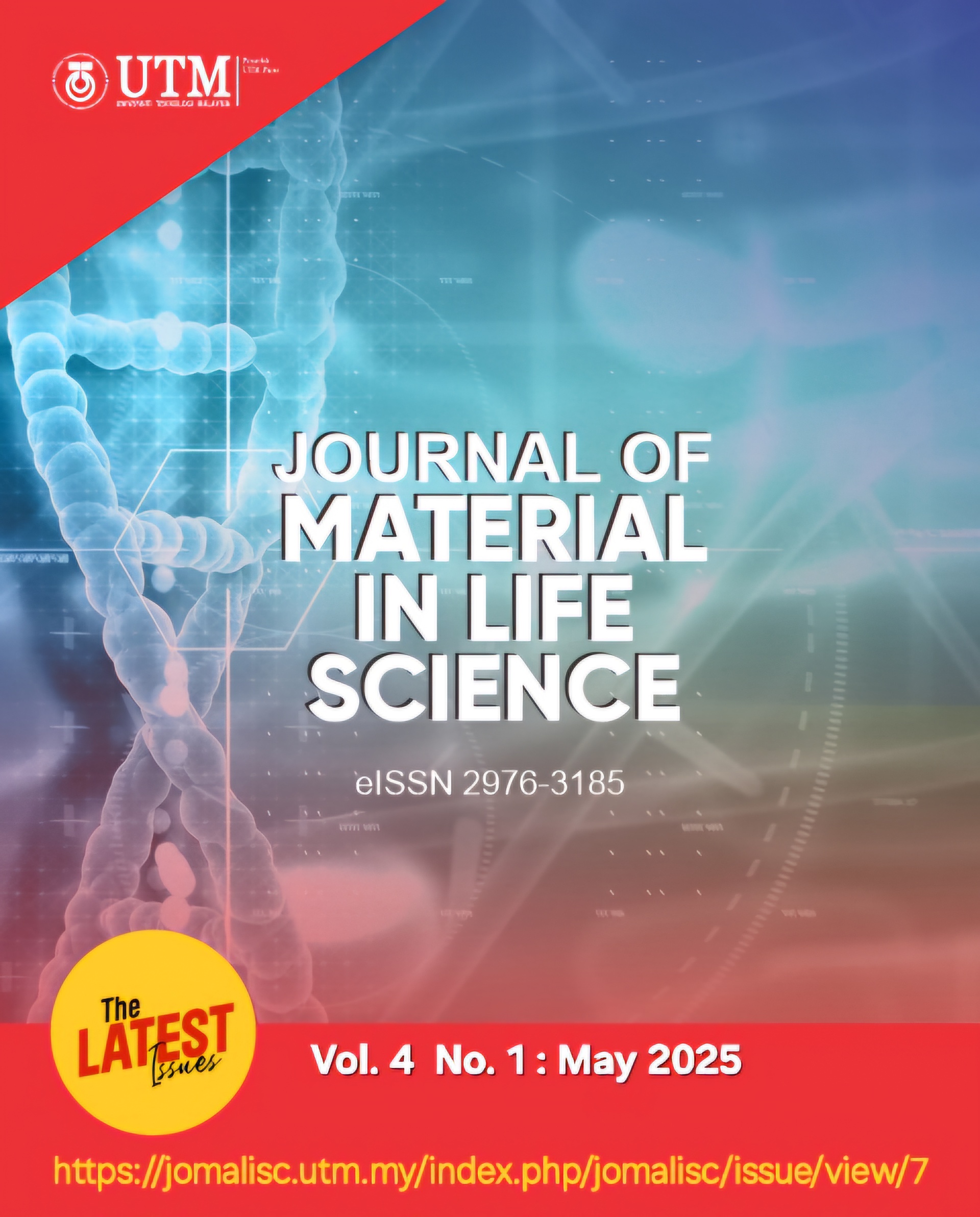In Silico RNA Aptamer targeting the Receptor Binding Domain of the SARS-CoV-2 Omicron Variant Spike Protein
DOI:
https://doi.org/10.11113/jomalisc.v4.94Keywords:
COVID-19, Omicron, in silico, aptamer, molecular docking, molecular dynamics simulationsAbstract
The rise of SARS-CoV-2 variants, especially Omicron, underscores the necessity for specific diagnostic tools. Aptamers are promising due to their high specificity and strong target affinity. This study aims to develop an RNA aptamer targeting the Omicron receptor binding domain (RBD. Initially, an oligonucleotide pool was constructed using RANDNA software and evaluated based on secondary structure properties. The 3D structures of the filtered sequences were modelled and docked with the Omicron RBD to identify the best aptamer candidates. The top three aptamer candidates which exhibited the highest number of binding site interactions, have been chosen for further analysis using molecular dynamics simulations. APT 6 exhibited negative docking score (-19.2 kcal/mol) and formed the greatest number of interactions with the mutated amino acids (G446S, Q493R, G496S, Q498R, N501Y and N505H) within the binding site. The RMSD and RMSF analyses of complex indicate good stability and flexibility, while Rg measurements reflected a compact and stable structure. The findings suggest that this APT 6 is tailored for detecting the Omicron variant, indicating its potential utility as a diagnostic tool.
References
World Health Organization. (2025). COVID-19 epidemiological update – 17 January 2025. https://www.who.int/activities/tracking-SARS-CoV-2-variants
Justo Arevalo, S., Castillo-Chávez, A., Uribe Calampa, C. S., Zapata Sifuentes, D., Huallpa, C. J., Landa Bianchi, G., Garavito-Salini Casas, R., Quiñones Aguilar, M., & Pineda Chavarría, R. (2023). What do we know about the function of SARS-CoV-2 proteins? Frontiers in Immunology, 14. https://doi.org/10.3389/fimmu.2023.1249607
Huang, Y., Yang, C., Xu, X. F., Xu, W., & Liu, S. W. (2020). Structural and functional properties of SARS-CoV-2 spike protein: Potential antivirus drug development for COVID-19. Acta Pharmacologica Sinica, 41(9), 1141–1149. https://doi.org/10.1038/s41401-020-0485-4
Chen, L., He, Y., Liu, H., Shang, Y., & Guo, G. (2024). Potential immune evasion of the severe acute respiratory syndrome coronavirus 2 Omicron variants. Frontiers in Immunology, 15. https://doi.org/10.3389/fimmu.2024.1339660
Cui, Z., Liu, P., Wang, N., Wang, L., Fan, K., Zhu, Q., Wang, K., Chen, R., Feng, R., Jia, Z., Yang, M., Xu, G., Zhu, B., Fu, W., Chu, T., Feng, L., Wang, Y., Pei, X., Yang, P., … Wang, X. (2022). Structural and functional characterizations of infectivity and immune evasion of SARS-CoV-2 Omicron. Cell, 185(5), 860–871.e13. https://doi.org/10.1016/j.cell.2022.01.019
Maffei, M., Montemiglio, L. C., Vitagliano, G., Fedele, L., Sellathurai, S., Bucci, F., Compagnone, M., Chiarini, V., Exertier, C., Muzi, A., Roscilli, G., Vallone, B., & Marra, E. (2021). The nuts and bolts of SARS-CoV-2 spike receptor-binding domain heterologous expression. Biomolecules, 11(12). https://doi.org/10.3390/biom11121812
Wandtke, T., Wędrowska, E., Szczur, M., Przybylski, G., Libura, M., & Kopiński, P. (2022). Aptamers—Diagnostic and therapeutic solution in SARS-CoV-2. International Journal of Molecular Sciences, 23(3). https://doi.org/10.3390/ijms23031412
Alhamid, G., Tombuloglu, H., Rabaan, A. A., & Al-Suhaimi, E. (2022). SARS-CoV-2 detection methods: A comprehensive review. Saudi Journal of Biological Sciences, 29(11). https://doi.org/10.1016/j.sjbs.2022.103465
van Beek, J., Igloi, Z., Boelsums, T., Fanoy, E., Gotz, H., Molenkamp, R., van Kampen, J., GeurtsvanKessel, C., van der Eijk, A., van de Vijver, D., & Koopmans, M. (2020). From more testing to smart testing: Data-guided SARS-CoV-2 testing choices. medRxiv. https://doi.org/10.1101/2020.10.13.20211524
Zhou, G., Wilson, G., Hebbard, L., Duan, W., Liddle, C., George, J., & Qiao, L. (2016). Aptamers: A promising chemical antibody for cancer therapy. Oncotarget, 7(12). https://doi.org/10.18632/oncotarget.7178
Osborne, S. E., & Ellington, A. D. (1997). Nucleic acid selection and the challenge of combinatorial chemistry. In Chemical Reviews, 97(2), 349–370. https://doi.org/10.1021/cr960009c
Dejnirattisai, W., Huo, J., Zhou, D., Zahradník, J., Supasa, P., Liu, C., Duyvesteyn, H. M. E., Ginn, H. M., Mentzer, A. J., Tuekprakhon, A., Nutalai, R., Wang, B., Dijokaite, A., Khan, S., Avinoam, O., Bahar, M., Skelly, D., Adele, S., Johnson, S. A., … Screaton, G. R. (2022). SARS-CoV-2 Omicron-B.1.1.529 leads to widespread escape from neutralizing antibody responses. Cell, 185(3), 467–484.e15. https://doi.org/10.1016/j.cell.2021.12.046
Hari, S., & Sudharsan, M. S. (2023). Molecular modeling and docking analysis of swine flu (H1N1) neuraminidase protein against the phytochemicals of Andrographis paniculata. Journal of Microbiology, Biotechnology and Food Sciences, 12(6). https://doi.org/10.55251/jmbfs.4751
Asif Mirza, Z., Naeem, A., Syed, A., Mateen, R. M., Fareed, M. I., & Husaain, M. (2023). In silico analysis to predict the pathogenic variants of CANT1 gene causing Desbuquios dysplasia (DBQD) type 1. Current Trends in OMICS, 3(1), 18–38. https://doi.org/10.32350/cto.31.02
Wong, F. C., Ong, J. H., & Chai, T. T. (2020). Identification of putative cell-entry-inhibitory peptides against SARS-CoV-2 from edible insects: An in silico study. EFood, 1(5), 357–368. https://doi.org/10.2991/efood.k.200918.002
Eberhardt, J., Santos-Martins, D., Tillack, A. F., & Forli, S. (2021). AutoDock Vina 1.2.0: New docking methods, expanded force field, and Python bindings. Journal of Chemical Information and Modeling, 61(8), 3891–3898. https://doi.org/10.1021/acs.jcim.1c00203
Li, Y., Liu, J., & Gumbart, J. C. (2021). Preparing membrane proteins for simulation using CHARMM-GUI. In Methods in Molecular Biology (Vol. 2302, pp. 237–251). Humana Press Inc. https://doi.org/10.1007/978-1-0716-1394-8_13
Sarkar, A., Sen, D., Sharma, A., Muttineni, R. K., & Debnath, S. (2021). Structure-based virtual screening and molecular dynamics simulation to identify potential SARS-CoV-2 spike receptor inhibitors from natural compound database. Pharmaceutical Chemistry Journal, 55(5), 441–453. https://doi.org/10.1007/s11094-021-02441-w
Bender, B. J., Gahbauer, S., Luttens, A., Lyu, J., Webb, C. M., Stein, R. M., Fink, E. A., Balius, T. E., Carlsson, J., Irwin, J. J., & Shoichet, B. K. (2021). A practical guide to large-scale docking. Nature Protocols, 16(10), 4799–4832. https://doi.org/10.1038/s41596-021-00597-z
Mulyani, D. E., Maksum, I. P., & Yusuf, M. (2024). In silico study of aptamer specificity for detection of insulin as development for diabetes mellitus diagnosis. Indonesian Journal of Chemistry, 24(3), 855–864. https://doi.org/10.22146/ijc.91602
Du, X., Li, Y., Xia, Y. L., Ai, S. M., Liang, J., Sang, P., Ji, X. L., & Liu, S. Q. (2016). Insights into protein–ligand interactions: Mechanisms, models, and methods. International Journal of Molecular Sciences, 17(2). https://doi.org/10.3390/ijms17020144
Sharma, J., Kumar Bhardwaj, V., Singh, R., Rajendran, V., Purohit, R., & Kumar, S. (2021). An in-silico evaluation of different bioactive molecules of tea for their inhibition potency against non-structural protein-15 of SARS-CoV-2. Food Chemistry, 346, 128933. https://doi.org/10.1016/j.foodchem.2020.128933
Ghahremanian, S., Rashidi, M. M., Raeisi, K., & Toghraie, D. (2022). Molecular dynamics simulation approach for discovering potential inhibitors against SARS-CoV-2: A structural review. Journal of Molecular Liquids, 354. https://doi.org/10.1016/j.molliq.2022.118901
Chen, D., Oezguen, N., Urvil, P., Ferguson, C., Dann, S. M., & Savidge, T. C. (2016). Regulation of protein-ligand binding affinity by hydrogen bond pairing. Science Advances, 2(3). https://doi.org/10.1126/sciadv.1501240
Bulusu, G., & Desiraju, G. R. (2020). Strong and weak hydrogen bonds in protein–ligand recognition. Journal of the Indian Institute of Science, 100(1), 31–41. https://doi.org/10.1007/s41745-019-00141-9


















